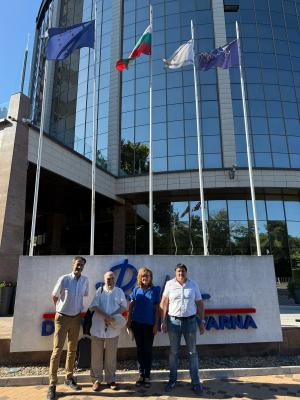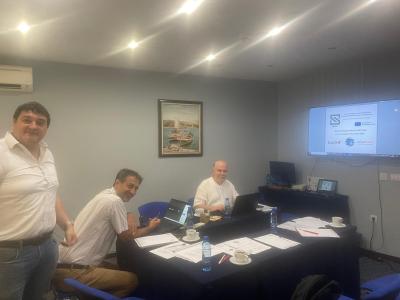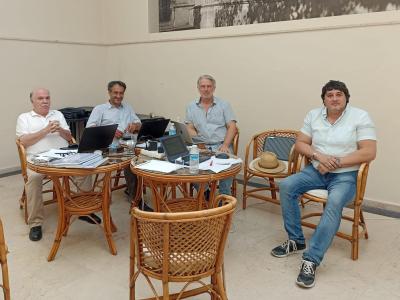The project aims to empower adults, educators, and enterprises by providing high-quality ergonomics education and practical training, ultimately enhancing workplace safety and well-being. The project seek to address the priorities of the Erasmus+ program by promoting adult education, improving the employability of adults, and fostering collaboration among organizations from different countries.

5th PLACE
EU Project of the Year Award
Strengthening Workplace Safety through Applied Ergonomics in the Digital Age (SAFE-D)
5th PLACE EU Project of the Year Award
Bulgarian Association of Ergonomics and Human Factors (BAEHF) - Bulgaria
"Safer Workplaces, Smarter Ergonomics – Together"

Engage on social media
Have a say and vote for this entry to win the People's Choice Award!
500 points per vote
Provide your email address and click on "vote". You will then receive an email that enables you to verify your vote by clicking on a link.
1500 points for each share/re-post; 500 points for each like
This entry has not provided any social media links for community voting.
Summary
Key People

Tihomir Dovramadjiev
Professor (Assoc.) PhD Eng.
BAEHF affiliated to International Ergonomics Association (IEA) & Federation of the European Ergonomics Societies (FEES),
Bulgarian Association of Ergonomics and Human Factors (BAEHF)

Rozalina Dimova
Professor PhD Eng.
BAEHF affiliated to International Ergonomics Association (IEA) & Federation of the European Ergonomics Societies (FEES),
Bulgarian Association of Ergonomics and Human Factors (BAEHF)

Gyula Szabó
Professor (Assoc.) PhD Eur Erg
Ergonómiai Mérnökiroda kft.,
DSGI

Mustafa Hilmi ÇOLAKOĞLU
Professor Dr.
CAPPADOCIA INNOVATION INSTITUTE TEKNOLOJİ LİMİTED ŞİRKETİ,
CAPPINNO
Acknowledgements
EUROPEAN ERASMUS + PROJECT
KA210-ADU-F26A6A52
Official website:
https://safe-d.eu/
PARTNERS:
DSGI Ergonómiai Mérnökiroda kft. (E10318915 - Hungary, HU)
https://www.dsgi.hu/
Bulgarian Association of Ergonomics and Human Factors (E10274857 - Bulgaria, BG)
https://baehfofficial.wixsite.com/baehf
CAPPADOCIA INNOVATION INSTITUTE TEKNOLOJİ LİMİTED ŞİRKETİ (E10319313 - Turkey, TR)
https://www.cappinno.com/
Images

SAFE-D Project TPM (1)

SAFE-D Project TPM (2)

SAFE-D Project TPM (3)

SAFE-D Project TPM (4)

SAFE-D Project TPM (5)
IMPACT STORY
Impacting lifesThe SAFE-D project will leave a lasting legacy by embedding ergonomics expertise into the long-term strategies of its partner organizations. Through a shared commitment to sustainability, partners will formalize roles and responsibilities to ensure project results—like training materials and ergonomics toolkits—remain accessible and actively promoted beyond the funding period. Each organization will develop tailored sustainability plans, integrating SAFE-D’s outputs into their core services, from SME consultations to adult education programs. The project also drives capacity building, equipping partners with advanced skills in ergonomics, digital workplace safety, and business engagement, enabling them to lead future initiatives with greater impact. By fostering stronger collaborative networks, SAFE-D creates a lasting ecosystem for knowledge exchange; partners will leverage these connections to replicate solutions, share best practices, and launch joint ventures. Dissemination efforts will extend through established stakeholder networks, ensuring educators, businesses, and policymakers continue to adopt SAFE-D’s resources—such as its adaptable curriculum and hybrid-work guidelines—to train adults and improve workplaces locally and across Europe. Engagement with authorities at EU, national, and local levels will amplify the project’s influence, advocating for policy alignment with ergonomics standards. Ultimately, SAFE-D transforms short-term collaboration into enduring progress: SMEs gain lifelong tools for safer workplaces, partners expand their expertise and outreach, and the project’s innovations become a benchmark for ergonomics in the digital age.
LEARNINGS
Lessons learned
The SAFE-D initiative reveals essential principles for implementing effective workplace ergonomics programs: (A1) Comprehensive Needs Analysis and Curriculum Design establishes that understanding local workplace realities must precede training development, as our multi-country research uncovered distinct ergonomic challenges requiring customized solutions. (A2) Practical Workshop Implementation demonstrates that employees best adopt ergonomic principles through direct, mentored application in their actual work environments. (A3) Structured Project Governance shows that maintaining clear communication channels, defined roles, and shared documentation systems enables successful cross-border collaboration while preserving flexibility for local adaptation.
Key leadership takeaways emerge: First, effective programs begin with listening - A1's research phase proved more valuable when engaging both workers and managers in identifying pain points. Second, transformation happens through doing - A2's on-site approach created immediate, visible improvements that motivated sustained practice changes. Third, longevity requires planning - A3's emphasis on sustainability frameworks ensures knowledge transfer continues beyond initial training phases. Together, these components form an integrated approach where research informs practice (A1 to A2), and systematic management (A3) amplifies and sustains the impact.
The project model confirms that successful ergonomic interventions combine diagnostic rigor, hands-on application, and organizational infrastructure - a replicable framework for addressing workplace safety challenges in SME environments across diverse cultural contexts.
FUTURE PLANS
What's coming?Building on SAFE-D’s success, our partners will expand the project’s impact through long-term sustainability plans, ensuring training materials and best practices remain accessible to SMEs beyond the project timeline. We will strengthen cross-border collaboration, leveraging our established network to develop new initiatives and share innovations in workplace ergonomics. Capacity-building efforts will continue, empowering partners to deliver advanced training and support to adult learners and businesses. Through active engagement with stakeholders, including policymakers and industry leaders, we will promote the adoption of SAFE-D’s methodologies at European, national, and local levels. Our dissemination strategy will maximize reach, enabling more organizations to replicate our proven approaches. By maintaining strong collaborative networks, we will foster ongoing knowledge exchange and create opportunities for future joint projects. SAFE-D’s legacy will endure as we remain committed to advancing workplace safety, enhancing education in ergonomics, and driving meaningful, lasting change for SMEs across Europe.

